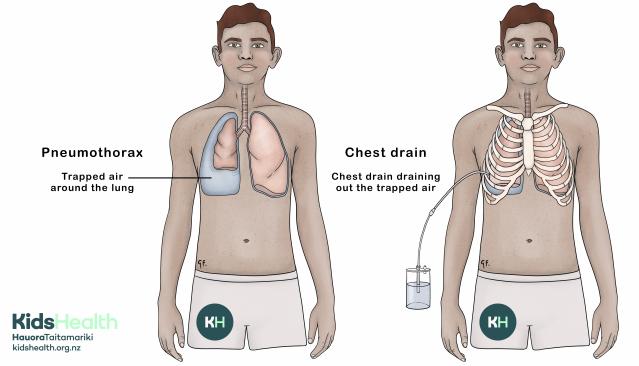Key points about pneumothorax
- a pneumothorax happens when air gets trapped between the lung and chest wall
- this happens because of a small tear in the lung
- a pneumothorax often happens suddenly, without warning
- a pneumothorax can be very serious, and is occasionally life-threatening
- If you are worried your child has a pneumothorax call 111 for urgent medical help
What is a pneumothorax?
A pneumothorax happens when air gets trapped between the lung and the chest wall. This occurs because a small tear in the lung means air can leak out. The trapped air around the lung can cause part or all of the lung to be squashed, or collapse. Sometimes this is called a 'collapsed lung'. A pneumothorax makes it harder to breathe.

Causes of pneumothorax
Spontaneous
A pneumothorax is usually spontaneous. This means it happens suddenly without a clear cause. It’s more common in tall, thin rangatahi (young people), especially boys.
Lung conditions
A pneumothorax can happen in tamariki (children) who have an underlying lung condition. This includes conditions like asthma and cystic fibrosis.
Tamariki and rangatahi with medical conditions such as Marfan syndrome or Ehlers-Danlos are more at risk of having a pneumothorax.
Injury
A pneumothorax can happen after an injury to the chest, such as a broken rib puncturing the lung.
Signs and symptoms of a pneumothorax
A child or young person with a pneumothorax may have:
- sudden sharp chest pain
- difficulty breathing
- a dizzy or lightheaded feeling
- a fast heartbeat
Diagnosing pneumothorax
Tamariki need a chest x-ray to show a pneumothorax. Some tamariki need a CT scan of their chest.
Managing pneumothorax
A small pneumothorax may not need any treatment and will get better on its own over a few days.
Chest drain
Sometimes a large pneumothorax, where there is trapped air around the lung, will need a chest drain. A doctor may put a chest drain in while your child is asleep under general anesthetic. But, if it’s an emergency and your child is very unwell, the doctor may need to put the chest drain in as quickly as possible without a general anaesthetic.
Tamariki usually need a chest drain for 2 to 5 days until there is no more air between the lung and chest wall.

Surgery
If the lung doesn’t expand properly, even after the chest drain, your child may need surgery to repair the leak in the lung. This is called pleurodesis - an operation to stick the lung to the inside of the chest wall.
Can pneumothorax happen again?
For most tamariki and rangatahi, this only happens once. Sometimes, a pneumothorax can come back. These tamariki and rangatahi may need pleurodesis to help stop another pneumothorax happening.
After a pneumothorax
If your child has had a pneumothorax, they are not allowed to fly unless they have had a chest x-ray that shows the pneumothorax has gone.
SCUBA diving can be very dangerous for someone who has had a pneumothorax. PADI, the diving organisation, strongly discourages anyone who has had a pneumothorax from diving.
